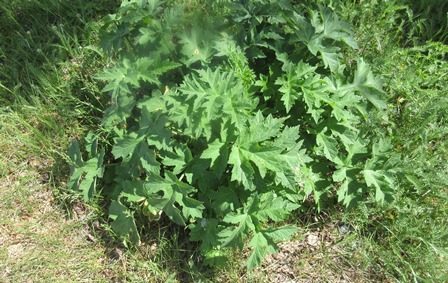It all began in February, when the snowfall was enormous. Our neighbours decided to move their snow up to our end of the street, where, theoretically, there was a bit more space. This wasn’t so popular with us, since the turnround area was becoming unusable, forcing cars to reverse into our driveway.
So one day we asked a neighbour if he would kindly not dump snow there. ‘Ah,’ he said, ‘I’ve been meaning to speak to you…’, and began to tell The Tale of the Loka.
There had been contractors here using Norwegian soil when they installed a new broadband cable system last year, and a plant had been introduced that way that was now spreading all along the street, a local kind of giant hogweed. He told us we had it in our garden and we needed to do something about it. It’s invasive, rampant, and dangerous to people.
It seemed a useful distraction from the snow dumping crime, and it almost worked. As we weren’t here last summer we wouldn’t have known about this. By the time we arrived back the garden was under a metre of snow. We took it with a pinch of salt.
And yet, as spring came, I found myself eyeing the ground rather nervously and searching on the internet for images of young hogweed. All those plants look the same when they first start to grow, small and green and leafy – who knows what they are? Not me.
My mood was up and down. One day I was convinced he was mistaken and we didn’t have any hogweed kind of plant at all. The next day I saw an army of them marching through the garden.
I intensified my online research, gathering facts and images. The enemy we were looking for was the Tromsöloka, a kind of loka (the family that includes the widespread cow parsley), very like giant hogweed. Originally from Iran, it’s a prized plant for the medicinal and culinary value of its seeds. Introduced to Norway in the early 19th century by – you guessed it – English horticulturalists, it’s particularly widespread in Tromsö, where it was a popular garden plant and a symbol for the town.
Since then its invasive quality and its ability to scar and blind people – if the sap is on the skin and allowed to interact with sunlight – is well known. It’s on the EU’s list of invasive species that should be controlled and ideally eradicated. Now I knew about it, it was on my list too. But first, I had to find it.
Did we, didn’t we? With protective gloves – not wanting to allow skin contact with the beast – I brought in leaf samples from all corners of the garden, finding only harmless loka of various kinds. No – we did not have the dreaded loka, hah!
Then coming back from an outing one day I turned to the street to where our postbox stands and saw a plant I’d never seen before. In fact, I would swear it hadn’t been there when we’d gone out, just three hours earlier. But approaching it I realised that the beast had been staring me in the face for a week, looking harmless and unexceptional among the grasses and buttercups.
A quick cross check on the internet confirmed it was the dreaded loka. I walked down the street and found the same plant outside, and sometimes inside, every single property. It is commonly spread by car tyres, and indeed that’s what it looked like. The plant was right by the position of the front wheel of the post van when it stops to deliver our mail, having skirted by the other places down the street where there are also plants.

We had to remove that loka before it got any bigger, and definitely before it started producing its thousands of spreading seeds. Death to the loka!
We bought the spade. We put on the protective gear (why can’t you get a hazmat suit when you really need one?). We wished each other luck and began digging. Gosh those roots are big. It’s a giant kind of parsnip underneath, deep down. Eventually releasing it, we manoeuvred it very carefully into a plastic bag for delivery to the dump (burnable waste only). Then we removed all our exposed clothing for the wash, and cleaned the tools.
Next we had to tell the local council that our street had a big problem with a dangerous, invasive plant. We notified them and waited for their response. They eventually replied saying there was just one particular loka that was in the invasive category in Kiruna, and if it was on private land it was the landowner’s responsibility, not the council’s.
We replied that it was mostly on the street – their land – and sent a dozen pictures to support our claim. Then we waited again.
We’re still waiting. We can’t help but feel there are similarities here, between how the authorities deal with giant hogweed in Sweden, and how they deal with coronavirus. The do nothing option seems the one in favour.
Postscript: A week later someone from the local agency responsible came to our street and pulled up all the loka before they could spread their seeds. They’ll be back of course – those particular loka – he didn’t dig up the roots – but we were relieved to feel the support. Now all we have to do is get someone in the country to take responsibility for the virus too….

